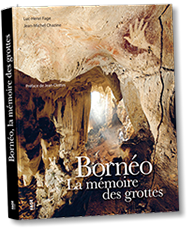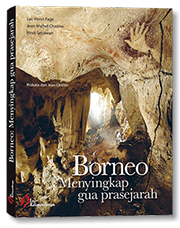Borneo, Memory of the Caves
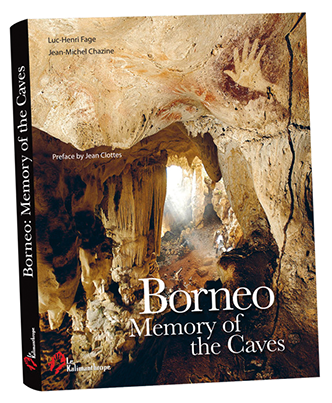
Texts and photos : Luc-Henri Fage,
With Jean-Michel Chazine and Pindi Setiawan
Preface by Jean Clottes
Preface by Dr. Jero Wacik
Ministry of Cuture and Tourism of Indonesia
Foreword by Elisabeth Proust
Translated by Lysa Hochroth
Edited by Alexandra Nicolescu
Borneo: Memory of the Caves is the account of an extraordinary adventure, told by the protagonists who made the exceptional discovery of the rock art murals of Kalimantan which are over ten thousand years old. Their findings shed new light on how populations developed between Southeast Asia and Australia.
Since 1988, in mission after mission, a profile of Borneo's ancient populations has emerged, suggesting not only their similarities with the Aboriginal people of Australia, but also the particular relationships they developed with the caves, by creating rock art characterized by an abundance of negative hands. Close to two thousand such hands discovered to date allow for new interpretations of this universal motif.
In this magnificently illustrated work, we discover not only the richness and complexity of an ancient region of the world, but also how today, this heritage is endangered.
34 € + postage
Hardcover with color dust jacket,
176 pages, over 360 color illustrations, paper Ultramat 135g. Weight of a copy: 1.250g.
ISBN 978-2-9536616-1-3
Le Kalimanthrope publisher, 2010
BUY THE BOOK:
Worldwide delivery.
SPECIAL ORDERS : send mail to info@kalimanthrope.com
Summary
Foreword by Élisabeth Proust,
President Director & General Manager Total E&P Indonésie
Preface by Dr. Jero Wacik 19
Preface by Jean Clottes . 20
Prologue 21
Part One
ADVENTURES IN THE LAND OF THE DAYAKS AND PUNANS
The Borneo Crossing 25
Pioneers in Archaeology 37
Part Two
DISCOVERING A UNIQUE ROCK ART
The Unexpected Discovery 55
On the Trail of Prehistory 71
Terra incognita 77
Part Three
BORNEO’S MANY “LASCAUX” CAVES
From Gua Masri to Ilas Kenceng 83
Gua Tewet: Apotheosis of Borneo’s Rock Art 103
The Anthropomorphic Figures of Gua Tamrin 117
Gua Ham: Negative Hands on Stage 127
The Women of Gua Jufri 135
The Honey Tree at Liang Karim 141
The Fabulous Bestiary of Gua Harto 147
Part Four
ARCHAEOLOGICAL PERSPECTIVES
The Birth of Kalimantan in Prehistory 155
Hand Play in Borneo 161
Will the Past Have a Future? 169
Maps of Documented Areas 172
Bibliography 174
Chronology 176
“Richly illustrated and very easy reading this book let you discover a mural art of it is five to ten thousand years, totally unknown.”
LIBÉRATION
“Written as a travelogue, richly illustrated with hundreds of photos, maps and diagrams, this book is to put in the hands of anyone interested in scientific and human adventure.”
NATIONAL GEOGRAPHIC
“The adventure book is therefore a great archaeological story, and keeps alive the great tradition of geographical exploration.”
CAFÉS GÉOGRAPHIQUES
Extract from the preface by Jean Clottes
Few speleologists, and even fewer archaeologists, have had the chance of a lifetime to discover a prehistoric cave with rock art. This kind of luck is prepared by intense work and reflection, nourished by experience. There are, however, some privileged moments in which hard work is or is not rewarded. Luc-Henri Fage and Jean-Michel Chazine are very lucky investigators who have come to know these moments of extraordinary plenitude. Yet what makes their adventure so exceptional is that it is not limited to a single cave. Indeed, their discoveries have multiplied before, and since 1998, the year in which they made so many of them. They have indeed discovered an entire region full of decorated caves.
Before Fage and Chazine came to research in Kalimantan, the rest of the world ignored the existence of rock art in the spectacular limestone peaks of these isolated regions, which remained protected by distance and luxuriant vegetation. The inhabitants were wary of outsiders as they coveted their harvesting of Salangane nests, a veritable natural goldmine. This underscores the perseverance that the two researchers had to maintain to overcome all kinds of obstacles, from administrative authorizations to the dangers of exploring these thick jungles. They were obliged to confront the perils of climbing steep cliffs, sometimes using vines, to reach the highest cavities where negative hands decorated the walls.
Borneo’s negative hands are so numerous and original, given the motifs and decorations found on them, that they are now rather famous among specialists. They are among the most mysterious and fascinating manifestations of rock art known. (...)
This book by Luc-Henri Fage and Jean-Michel Chazine is elegantly illustrated with magnificent photography, opening the door to a world heretofore unknown. The spectacular nature of prehistory unfolds to reveal the necessary scientific rigor used to study the themes and techniques, and propose new research (such as on the gender of the artists who created them). These are the hands that lead us to the dreamworld.
The heritage of Kalimantan is unique in rivaling the most celebrated artistic traditions of humankind. It clearly merits protection in order to preserve it from the dangers presented by the vulnerable environment that surrounds it. This book, by making it known, will contribute greatly, we can hope, to its protection and preservation forever after.
Jean Clottes
prehistorian
Conservateur général du
Patrimoine honoraire
The authors
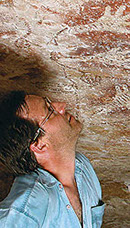 Luc-Henri Fage
Luc-Henri Fage
Luc-Henri Fage is a photographer, journalist, graphic artist, documentary filmmaker, and explorer. His passion for adventure has led him to raft down the Zaire River, make the second ever south to north crossing of West Papua (Indonesia), and participate in speleological expeditions there and throughout New Guinea, Algeria, and, more recently, Chilean Patagonia, often with his camera in hand. In 1988, while crossing Borneo from east to west, he came upon a cave decorated with charcoal drawings that intrigued him. In 1992, he organized the first in a long series of missions back to the island with ethno-archaeologist Jean-Michel Chazine.
 Jean-Michel Chazine
Jean-Michel Chazine
Jean-Michel Chazine is an ethno-archaeologist at the Centre national de recherches scientifiques (CNRS) and member of the Centre de recherche et de documentation sur l’Océanie (CREDO) in France. He departed from his training in physical metallography engineering to begin his anthropological research with the First Peoples in Tahiti and Tuamotu, in the atolls of French Polynesia. After meeting Luc-Henri Fage, he left Oceania to focus on their pioneering expeditions into the heart of Borneo, a virgin territory for archaeological investigation.
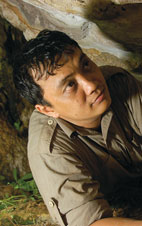 Pindi Setiawan
Pindi Setiawan
Pindi Setiawan lecturer in visual art and language at the Faculty of Art and Design, Bandung Institute of Technology (ITB), Indonesia, researches the visual communication of non-literate peoples from prehistory to the present. An avid explorer of his native Indonesia, in 1991, he started investigating prehistoric rock art in the Moluccas, in Sulawesi, and in West Papua. In 1995, he began a remarkable journey, accompanying Luc-Henri Fage and Jean-Michel Chazine on their search for the “lost” cave paintings of the spectacular Sangkulirang Karst. Today he is well known for his research on the rock art of Indonesia.
THE PDF FILE IS ALSO AVAILABLE FOR FREE IN ENGLISH
https://www.researchgate.net/publication/335541016_Borneo_Memory_of_the_Caves
Flip through the book

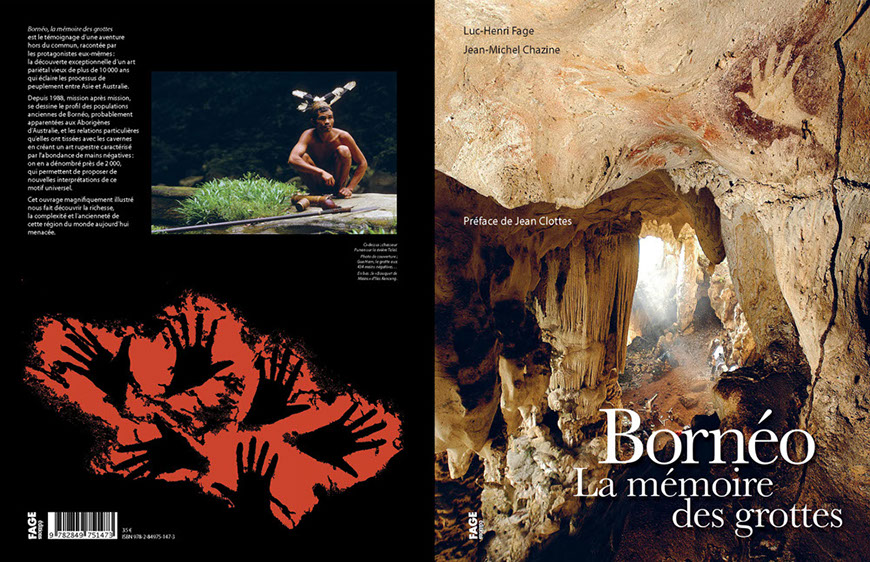
















18 - 18
<
>
